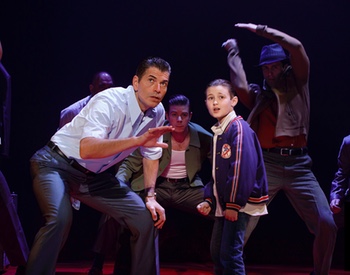Through Sun 6/30
Photo by Steve Wagner
Three families, one white and wealthy, one immigrant and poor, and one black and on the rise, represent turn-of-the last century dynamics. Instrumental and vocal music — not just ragtime, but klezmer, waltzes and more — expresses their emotions, hopes, and dreams.
The story follows what happens when (among other things) Mother (Bridie Carroll) finds an infant in the garden of her comfortable suburban estate. She takes in (and loves) the baby who, as it turns out, is the child of the black servant Sarah (Mariah Burks) and her lover, the soon-to-be-famous ragtime musician Coalhouse Walker, Jr. (Eugene Sumlin). At the same time, penniless Jewish immigrants Tateh (Scott Esposito) and his young daughter (Elise Pakiela) have just arrived in the United States. Ragtime tells what happens as their lives intertwine over the years.
There’s heartbreak, violence, injustice (no one is an angel here, except the little children), and new-found happiness and reconciliation. Something for everyone.
Overall, it’s a delightful summer show with several outstanding performances. As a peacekeeper, Bridie Carroll’s “Mother” handles her pivotal role with elan and grace. Burks’ Sarah shows passion in her despair and pride. While Sumlin’s smooth Coalhouse Walker adds panache to the portrayal of his proud, self-respecting character, at times he seems a little too gentle in his anger.
Displaying great fire, Nyla Watson as “Sarah’s Friend” rocks the first-act ending with a moving, full-voiced “Till We Reach That Day.” In the final scenes, Isaiah Jackson, as Coalhouse’s and Sarah’s little son, is so darn cute it’s just as well he doesn’t appear earlier in the show — he’d have stolen every scene. (As an infant, he’s represented by several alarmingly small bundles carried around by Mother. Real mothers in the audience exchanged wry smiles about baby’s unbelievable size and silence.)
Esposito’s Tateh illustrates beautifully (both literally and figuratively) how creativity can bring wealth without sacrificing compassion. Esposito and Carroll (Mother) persuade us that love prevails in the affirming “Our Children.”
Beauty Anna Barrett, playing celebrity tramp Evelyn Nesbit (and singing “The Crime of the Century”), brings a wicked sense of humor to the role.
The newly configured in-the-round Alma Theater stage should also get special mention. Ragtime can be a big production for large spaces (as it was in Toronto in 1996 when I first saw it). The new oval space at Cain Park meant that the cast (over two dozen) could be seen and heard by people on all four sides at once, thanks to choreographer Imani Jackson and the director. Big kudos to artists Brittany Ganser and Justine Schneider for handcrafting the cleverly imagined setting that brought us closer to the story.
Credit for “making it real” should also go to set and lighting co-designers Trad A Burns and Ben Gantose who found a new use for pianos and also created an amazing staircase. Costume designer Tesia Dugan Benson and wig designer Janel Moore brought the era alive. Sound designer Carlton Guc handled the tricky acoustics so that even when characters were not facing us, we could still understand them. Jordan Cooper directed the small above-stage orchestra that ably handled the show’s various styles.
BOTTOM LINE: Filled with tunes great and small, Ragtime mixes history with music. If visual art also intrigues you, then visit the Cain Park’s Feinberg Gallery (next to the Alma) while you are there. Running through July 21, the current exhibition The Ends of the Earth … Lead You Home features photography by Will Slabaugh and Catherine McManus. Slabaugh’s intriguing photographs taken in Japan (and printed on handmade paper) show in subject and creation how old and new can blend. McManus’s varied photographs document her visit to the United Kingdom.





